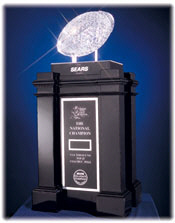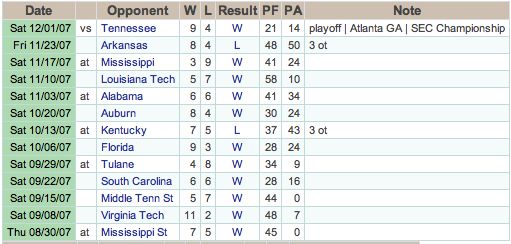I have been thinking about doing such a timer myself, but Averag Joe has it covered. A snap of his site is below. Visit whenever you’d like to know how much time is left in the hourglass.

I have been thinking about doing such a timer myself, but Averag Joe has it covered. A snap of his site is below. Visit whenever you’d like to know how much time is left in the hourglass.



As you may know (and care about or not,) the Ohio State Buckeyes will meet the Louisiana State Tigers in New Orleans January 7th, 2008 to decide the national championship for the 2007 season of Division I college football. DI (now called Bowl Championship Division) is the only division in college football that does not decide the winner of the championship through a playoff system, it’s rather, a playoff game where the participants are selected on the basis of the college coaches poll, a private poll (Harris Interactive), and the average of 6 computer ranking systems with each component accounting for 1/3 of the overall rating.
That’s how the teams got here. Now when you hear gripes and groans from outside Baton Rouge and Columbus, you’ll know why. With the preamble out of the way, this entry looks at the LSU team and the season they’ve had building up to their appearance in the championship game. I’ll do a similar entry for the Buckeyes at a later date and ultimately a game preview.
By any measure the Tigers have had a successful season, amassing over 500 points in 13 games for nearly 39 points per game average. Late in the season the offense execution was off a bit as there were some key injuries to quarterback Matt Flynn and tailback Keiland Williams taking away some of the dynamic performance witnessed earlier in the season. On the defensive side of the ball LSU has had some impressive performances holding teams under 20 points per game and shutting out Mississippi State and Middle Tennessee State. The defensive performance later in the year was adversely affected by a key injury to defensive tackle Glenn Dorsey.
The Tiger’s schedule was comprised of 9 conference and 4 out-of-conference games against Louisiana Tech, Tulane, Middle Tennessee State, and Virginia Tech. The most impressive victory of the season for the Tigers was a 48-7 demolition of eventual ACC Champion and BCS participant Viriginia Tech. I watched that game, and I was impressed. I certainly believed that LSU was playing the best football of the season watching their performance in that game. Their OOC opponent’s collective win/loss total was 25-24.
In conference, LSU played 8 regular conference games and plus the SEC Championship game against Tennessee. As impressive as LSU was early in the season, conference play made me wonder if perhaps as a team they had peaked too early in the season. Depending on your perspective, you could judge the season this way: Optimistic view point – LSU was two plays away from an undefeated season and undisputed #1 ranking. Or, the pessimistic view point – LSU was three plays away from being 7-5 playing in a thisbowlsucks.com venue in late December. There is a kernel of truth to be found in each perspective I think.
LSU’s conference foes posted a 63-46 win/loss record which tells you that the SEC had a stellar out-of-conference win rate (they did, over winning over 80% of their games.) Thus, the combined conference and OOC record of opponents was 88-70. A summary of LSU’s schedule is posted below:

I’m not ready to make a call on the game yet, I’ll do that in a future entry. But I think the matchup is a good one and I can easily see LSU winning. But I’m not convinced that the mismatch many predict will come to pass based on the makeup of the teams and coaches involved in the game. I will say, whomever wins more battles on the line of scrimmage will win a very physical game.
Since the net is a large and varied population, I thought I’d take the time to practically explain different kinds of linking and why they are good or bad. Our friends over at Dvorak.org still seem to be confused about linking, deep linking, and hot linking. Hopefully this entry will be an aid to help sort out the differences in practice. Pragmatic examples are probably best.
Linking is the practice of using an anchor tag (<a href=”URL”>descriptive text of link</a>) that references the address of another web resource. A practical example of linking is sending an audience to Dvorak.org’s main page. There is nothing wrong with this, it’s the thing that makes the web the web. It’s beneficial to an author because one can reference something at another location that enhances the topic being discussed. This is a good practice because it a) enhances the richness of experience for a reader and b) distributes traffic to the sources of content other than the piece being read at the moment. Verdict: Linking = Good
Wikipedia’s entry on (hyper) linking.
Deep Linking is the practice of using an anchor tag as described above. But instead of directing the traffic to the main page, the traffic is directed to a specific page that contextually makes sense to the reader. An example of deep linking is this sending you to the latest article on Dvorak.org referencing linking and China’s objection to Yahoo’s linking practices. As above, there is nothing wrong with this practice since it sends the reader back to the source site to gain information that enhances the experience for the reader and both the linking and source sites are identified and participate in the traffic. Verdict: Deep Linking = Good (Despite what China may think of the practice.)
Wikipedia’s entry on deep linking.
Hot Linking is different, instead of using the anchor tag discussed above, it makes use of the <img src=”URL”> tag to typically display an image inline from the alternate source. Let’s just say I chose to embed the image used in the Dvorak.org linking article and displayed it here, that would be hot linking.
hot link code: <img src=”https://images.businessweek.com/ss/06/07/top_brands/image/yahoo.jpg”> (Notice that this image is hot linked from Dvorak.org and hosted by Business Week – not exactly what I was expecting to see when I selected this example…who knows, maybe they have an agreement in place that covers this use.)
It’s an annoying and rude practice, but frequently is used. A web master may put in place access controls to discourage the practice if they so choose, but there are easy work arounds. When a fellow web site hot links, there can be two types, with attribution citing the source of the resource being used (polite) and not providing attribution. So for instance, if I had hot linked the image from the entry above and placed something around or near the image saying “Photo Credit: Business Week” with a link back that would be hot linking with attribution – still rude, but above board. When hot linking happens without attribution is when the situation moves from being impolite and rude to insidious and potentially criminal. Why you ask? Because the hot linking site (Dvorak.org in the case above) gets full benefit of the resource displayed, bandwidth, and is shielded from an legal responsibility in the case that it is copyright protected material. The hosting site (BusinessWeek.com in the instance above) pays the freight and derives zero benefit from the link. Verdict: Hot Linking = Bad
Wikipedia’s entry on (inline) hot linking.
In the end, this isn’t really a legal issue (though I’m sure many want it to be) it’s an etiquette issue. When you link to someone, that’s a good thing as all parties are identified and participating. If you hot link to an image with attribution, it’s rude and the hot linker might expect contact from the hosting site to move the image reference. If you hot link to an image without attribution that provides all the value to the hot linker is extremely rude and possibly illegal. If the site hosting the resource complains to the hot linker about the situation, it’s the hot linker’s responsibility to do something about it.
One other issue that I’ll broach is copyright infringement. When someone creates original content, they can protect it by copyright. When you see Copyright or the © symbol (usually on a footer) that means the content owner has retained the rights. Retaining rights does not necessarily mean the person wants to hold you up for money to use the resource, it means they want to participate in how the resource is being used. I’ll make this personal, for me, a non-artist, it’s about attribution. When someone uses original content from this site, I’d like to have a reference back to the source (a link or deep link) so I have the opportunity to participate in discussion. Others may want to be compensated. But beware, regardless of how the content is referenced, it still may be subject to copyright and it’s worth the time to understand that situation before using the resource.
In the end, the easiest possible practice for everyone involved is to host images locally and provide a small “photo credit” or image credit tag. It’s polite, it keeps to the spirit of sharing information, and it forestalls issues. And, keep on linking (even deep linking) it’s what makes the web go ’round.
Let’s hope last night’s game between Navy and Utah provides a glimpse into the remaining 31 match-ups to be played. The Middies led most of the game leading up to an exciting 29 point explosion by both teams in the final stanza. With about a minute and a half remaining, Utah scored to go up by 10 points. Most people thought the game was over at that point, but not Navy. The Midshipmen promptly scored a touchdown on a long pass play closing the gap to 3 points, recovered an onside kick, and then started to march down the field with just under a minute to go.
Utah safety Joe Dale sealed the game with an interception in Utah territory with just under 30 seconds to go to seal the win. The game was well played and exciting, a great way to start the bowl season. Let’s hope the other games are just as competitive and exciting.